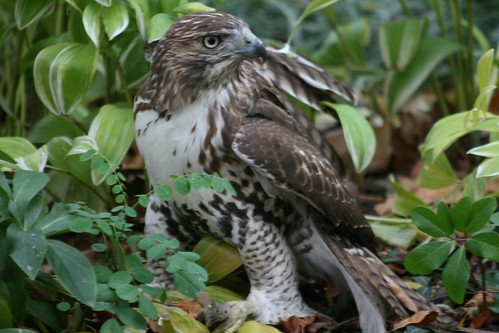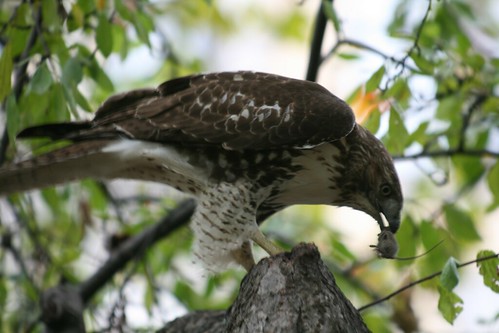Raptors Need YOUR help - RIGHT NOW!!!

New York, Tompkins Square Park: 11\14\07 For the second year, a juvenile Red Tailed Hawk has visited Tompkins Square Park, in search of rodents and the occasional pigeon. It may well be that this young visitor is just what the neighborhood is seeking, as ideas are being floated to give pigeons birth control, fine people who feed them, and place poison in the park for rodents.
In answer to a question about the effect on the hawk, of poisoning the rodents in Tompkins Square park, "It can't be good for him," says Gregory Gough Avian Ecologist, Migratory Bird Center of the Smithsonian Institution in Washington, DC. "You might try letting the hawk do the job himself, he can eat quite a lot of rodents." He suggests the Board of Health curtail the poison program in Tompkins Park from November until mid December when we will find out if this young hawk decides to become a permanent resident of the East Village. He explains that the older birds find permanent territory, and the younger ones are migratory as they seek a place to settle.

After speaking with Gregory Gough, I discovered that difethialone was the poison used in Tompkins Square Park. Difethialone. According to "Toxicology" by G. D. Osweiler, published by Williams and Wilkins, Media, Pennsylvania.(1996)it is a second generation anticoagulant poison. It interferes with vitamin K, a clotting factor. It kills the targeted organism by effecting massive internal hemorrhaging. What defines the second generation of these poisons, is the ability to kill after a single ingestion of the poison.
In the first week of November, packets of Difethialone were placed in the burrows of the rodents in the park. A week later a young hawk was seen feeding on mice about 10 feet from the sign warning of the poisoning. In a toxicology report on the death of a young female Red Tailed Hawk, Ward B. Stone, a wildlife pathologist with the New York State Department of Environmental Conservation, writes "We have found the anticoagulant rodenticides to be important secondary poison of raptors."
Second generation anticoagulant rodenticides have been banned in other places due to their deadly effect on raptors. The San Francisco Commission for the Environment banned these poisons after the death of a Red Shouldered Hawk in Golden Gate Park. The harm this class of poison can cause is impressive. Mountain lions and endangered San Joaquin Kit Foxes have died as a result of ingesting prey which fed on second generation anticoagulant poisons.
Michael Fry, of the American Bird Conservancy feels that there is no safe season for use of second generation anticoagulant rodenticides. Most hawks migrate to South America during the winter, but some do stay in warmer climates. He suggests a return to the less toxic first generation rodenticides: Chdrophacinome, Diphacinone and Warfarin. Fry explains that a rodent who eats either the first or second generation anticoagulants will take from four to seven days to die. During that time the animal might be eaten by a predator, such as a raptor. In the case of a second generation anticoagulant, where a single ingestion can cause death the rodent may have eaten the poison several times over those days, building up a super lethal dose. In the same period of time, ingesting doses of the first generation anticoagulants, the animal would have a less dangerous dose in its body at the time of ingestion by a predator.
"The EPA has put forward a mitigation plan, to take all the second generation anticoagulants off the consumer market, allowing only first generation anticoagulants to be sold over the counter. Only licensed pest control experts will be allowed to use the second generation poisons in tamper resistant baiting stations. We want the use of these second generation anticoagulants to be restricted to indoor use alone," says Michael Fry.



3 Comments:
The Mayor of London bought in a few Hawkes a year or two ago to scare the pigeons from Trafalgar Square. Every now and then they bring them back in, with handlers, and let them fly around a bit. Works a treat: the pigeons see it happening a lot, and they bugger off.
It's much safer than poisons.
There is not just one Red tailed hawk in TSP but on occasion this year 3 ,probably siblings that have not yet gone their seperate ways , that regularly frequent TSP.
Immature Red Tailed hawks have been coming to TSP every fall for at least the last 30 years that I have been watching them .Adult hawks with red tails have of course been visiting TSP for a snack every-now-and-then since ever there was a TSP.
Any rodenticide that contains difethialone is now already a registered rodenticide with an EPA number and can only be sold to and placed by a certified exterminator . By law today without certification you should not be able to buy a difethialone containing rodenticide .
In NY state 58% of the Red tailed hawks tested showed on testing a presence of difethialone in their blood . This is all documented in links to a post on the subject on www.neithermorenorless.blogspot.com .
Red tailed hawks nesting in this area do not migrate , only those living in the far north come south to our NYC lattitude in the winter .
Though it is true that the species Buteo jamaicensis is present represented as many different sub-species in habitats from the arctic to near Patagonia the hawks that we know as Red Tailed hawks in TSP ( Buteo jamaicensis borealis ) do not migrate to South America . This hawk is territorial and once joined with a mate maintains a year round presence in its territory , at least from this lattitude south .
The immature hawks seen every October to March in TSP are in TSP because they have been pushed out of their parents territory by their parents who are beginning to prepare for a new mating cycle .
Despite the very real threat of rodenticide use to Buteo jamaicensis borealis the species is actually growing in number, for now at least .
Pesticides are a deadly problem for wild life and should be used as sparingly and safely as possible .
I loved your hawk photos when I first saw these pictures on your Flikr site, Lorcan. I had no idea the story behind the shots. Puts them in a whole different light!!!
Anyone know if avian or environmental groups are lobbying on behalf of the NYC raptors? There are peregrine falcons downtown too. Would imagine the poison effects them as well. Would be interested in knowing if there are existing efforts to which we could lend support.
Post a Comment
<< Home